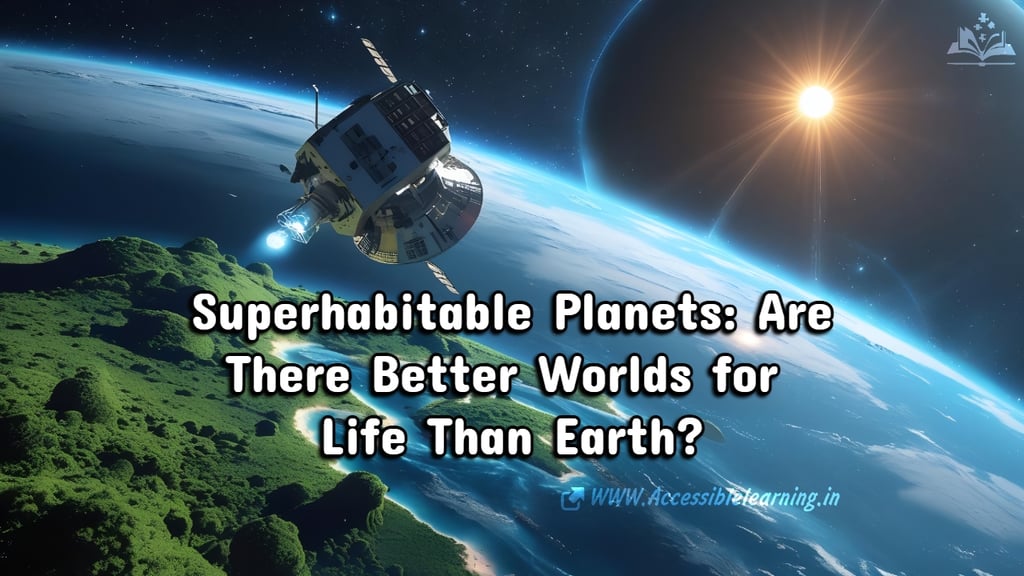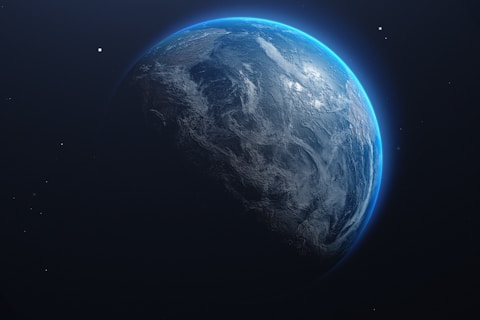
Superhabitable Planets: Are There Better Worlds for Life Than Earth?
Could there be planets more suitable for life than Earth? Explore superhabitable exoplanets like Kepler-442b, Kepler-22b, and TOI-700 d, which may offer even better conditions for sustaining life. Discover the future of space exploration and what it means for humanity!
SPACE/TECHSPACE MISSIONEDUCATION/KNOWLEDGEISRO/NASA
Sachin K Chaurasiya
2/7/20255 min read


Earth is the only known planet to support life, but what if there were planets with conditions even more suitable for sustaining life? Scientists have discovered exoplanets—planets outside our solar system—that might offer better environments for life than Earth itself. These so-called "superhabitable planets" could have more stable climates, stronger magnetic fields, and larger habitable zones. Let’s explore some of these fascinating worlds.
What Makes a Planet Superhabitable?
For a planet to be considered better than Earth for life, it should have:
A Stable Climate: A long-lasting, balanced atmosphere that supports complex ecosystems.
A Strong Magnetic Field: Protection from harmful cosmic radiation.
Optimal Gravity Levels: Slightly higher gravity than Earth to retain a thick atmosphere.
More Oxygen in the Atmosphere: Helps sustain larger and more advanced life forms.
Land and Water Balance: A mix of continents and oceans for diverse ecosystems.
A Longer-Lived Star: Red dwarfs or orange dwarfs live longer than our Sun, providing stable conditions for billions of years.
Geological Activity: Active plate tectonics can help regulate carbon levels and maintain a stable climate.
Presence of a Thick Atmosphere: A thick atmosphere can provide the right amount of greenhouse effect to keep temperatures stable.
Potential Superhabitable Planets
Kepler-442b—A Rocky Super-Earth
Distance: 1,206 light-years away
Size: 1.34 times the size of Earth
Star Type: Orange dwarf (cooler and longer-lived than our Sun)
Habitability: Kepler-442b is in the habitable zone, meaning it could have liquid water. Scientists believe its atmosphere might be capable of supporting life.
Kepler-22b—A Water World?
Distance: 600 light-years away
Size: 2.4 times Earth’s size
Star Type: Sun-like star
Habitability: This exoplanet orbits in the habitable zone, and some models suggest it could be covered in vast oceans, making it a potential haven for aquatic life.
Gliese 667 Cc—A Warm, Earth-Like World
Distance: 23.62 light-years away
Size: 1.6 times the size of Earth
Star Type: Red dwarf
Habitability: Scientists believe Gliese 667 Cc receives a similar amount of energy from its star as Earth does from the Sun, increasing the possibility of liquid water and life-friendly conditions.
LHS 1140b—A Rocky Exoplanet with a Thick Atmosphere
Distance: 40 light-years away
Size: 1.7 times the size of Earth
Star Type: Red dwarf
Habitability: LHS 1140b is a dense, rocky planet that may have a thick atmosphere capable of trapping heat, making it a strong candidate for habitability.
TOI-700 d—A Promising Earth Twin
Distance: 100 light-years away
Size: 1.2 times the size of Earth
Star Type: Red dwarf
Habitability: TOI-700 d orbits within its star’s habitable zone and could have an atmosphere similar to Earth’s. It is one of the best candidates for further study.
K2-18b—A Potentially Habitable Mini-Neptune
Distance: 124 light-years away
Size: 2.6 times Earth’s size
Star Type: Red dwarf
Habitability: Scientists have detected water vapor in K2-18b’s atmosphere, and it could have conditions suitable for microbial life or even more complex organisms.
Are These Planets Truly Better Than Earth?
While these planets have promising conditions, Earth remains the only confirmed planet to host life. Scientists continue to study these exoplanets using advanced telescopes like the James Webb Space Telescope (JWST). Future space missions may provide deeper insights into their atmospheres, surfaces, and potential for alien life. Additionally, new discoveries may refine our understanding of what makes a planet truly habitable.




Future of Exoplanet Exploration
The search for habitable planets is just beginning. Upcoming space missions and telescopes, such as
James Webb Space Telescope (JWST)—Analyzing atmospheres for biosignatures.
Nancy Grace Roman Space Telescope—Searching for more exoplanets.
European Extremely Large Telescope (ELT)—Offering detailed imaging of exoplanetary surfaces.
LUVOIR (Large UV/Optical/IR Surveyor)—A proposed next-generation observatory to identify habitable worlds.
These technologies will help us determine if life exists beyond Earth and if there are planets that could truly be superior to our own.
FAQ?
What is a superhabitable planet?
A superhabitable planet is an exoplanet that has conditions potentially more suitable for life than Earth. These planets may have a stable climate, a stronger magnetic field, balanced land and water distribution, and a longer-lived star.
Are there any confirmed superhabitable planets?
Scientists have identified several promising candidates, such as Kepler-442b, Kepler-22b, Gliese 667 Cc, LHS 1140b, TOI-700 d, and K2-18b. While they meet some criteria for habitability, further study is needed to confirm if they are truly superhabitable.
What makes a planet better than Earth for life?
A stable and mild climate
A thick atmosphere with oxygen
Moderate gravity for sustaining an ecosystem
A strong magnetic field for protection against radiation
A host star with a longer lifespan than our Sun
Can humans live on these planets?
While some exoplanets may have Earth-like conditions, no direct evidence suggests they are suitable for human habitation yet. Future space missions may reveal more about their atmospheres and surfaces.
Which space missions are searching for habitable exoplanets?
Missions like the James Webb Space Telescope (JWST), Nancy Grace Roman Space Telescope, and European Extremely Large Telescope (ELT) are studying exoplanet atmospheres for signs of life.
Could life already exist on these planets?
It’s possible! If a planet has liquid water, a stable atmosphere, and the right chemical elements, microbial or even complex life forms could exist. Scientists are searching for biosignatures, like oxygen and methane, as clues.
Will we ever travel to these planets?
Currently, interstellar travel is beyond our technological capabilities. However, advancements in space travel, such as warp drives, generation ships, and cryogenic sleep, could make it possible in the distant future.
How far away are these superhabitable planets?
Most of these exoplanets are dozens to thousands of light-years away, making them inaccessible with current technology. However, planets like Gliese 667 Cc (23 light-years away) are among the closest potential candidates.
How do scientists study these planets from Earth?
Astronomers use telescopes like JWST, Hubble, and ground-based observatories to analyze a planet’s atmosphere, temperature, and chemical composition using techniques like spectroscopy.
Why is Earth still the best planet for life?
Earth is the only confirmed planet with life because it has a perfect balance of temperature, water, atmosphere, and geological activity. While superhabitable planets may exist, we still have no direct evidence that they are truly better than Earth.
What role does a planet’s atmosphere play in habitability?
A planet’s atmosphere regulates temperature, protects against harmful radiation, and supports essential gases like oxygen and carbon dioxide. A thicker atmosphere can help trap heat, making the planet warmer and more suitable for life.
Could exomoons also be superhabitable?
Yes! Large moons orbiting gas giants in the habitable zone could have their own atmospheres, liquid water, and stable conditions for life. Scientists are actively searching for habitable exomoons around distant exoplanets.
How do scientists determine if a planet has water?
They use spectroscopy to analyze the light passing through an exoplanet’s atmosphere. If certain water-related molecules, such as H₂O vapor, are detected, it suggests the presence of liquid water, a key ingredient for life.
What is the difference between an Earth-like planet and a superhabitable planet?
An Earth-like planet shares key similarities with Earth, such as size, temperature, and atmospheric composition. A superhabitable planet, however, has conditions that might be even better for sustaining life, such as a more stable climate or a stronger magnetic field.
How long would it take to reach the nearest superhabitable planet?
With current technology, it would take thousands to millions of years to reach the nearest potentially habitable exoplanets. Future advancements, such as light-speed travel or warp drives, might one day make interstellar journeys possible.


The idea of planets more habitable than Earth is both exciting and thought-provoking. While we have yet to confirm life beyond our world, these exoplanets remind us that our universe is vast and full of possibilities. As space exploration advances, we may one day find a true superhabitable paradise beyond Earth!
Subscribe To Our Newsletter
All © Copyright reserved by Accessible-Learning Hub
| Terms & Conditions
Knowledge is power. Learn with Us. 📚


